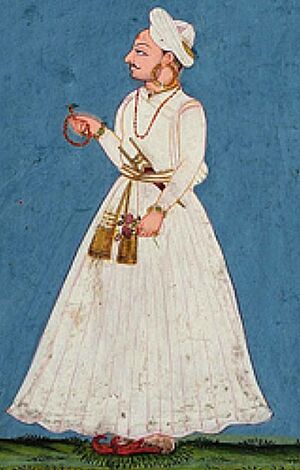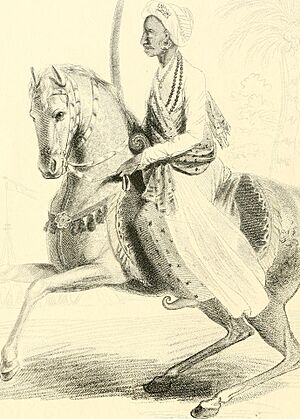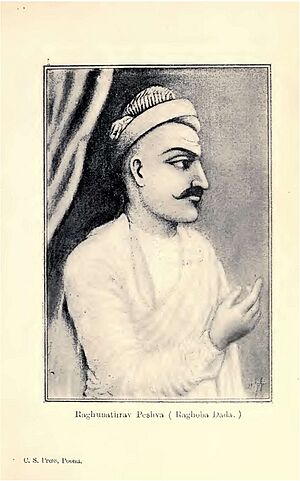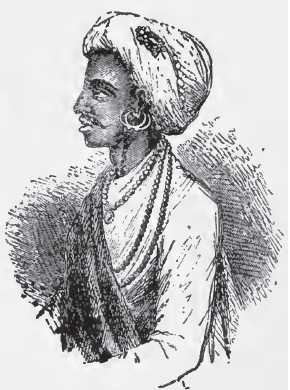Raghunath Rao facts for kids
Quick facts for kids
Raghunath Rao
Bhat
|
|
|---|---|

Painting of Raghunath Rao by an unkonwn artist.
|
|
| In office 5 December 1773 – 28 May 1774 |
|
| Monarch | Rajaram II |
| Preceded by | Narayanrao |
| Succeeded by | Madhavrao II |
| Personal details | |
| Born | 18 August 1734 Satara, Satara State, Maratha Confederacy |
| Died | 11 December 1783 (aged 49) Kopargaon, Maratha Confederacy |
| Spouse | Janakibai Anandibai |
| Children |
|
| Parents |
|
| Relatives | Balaji Baji Rao (brother) |
| Residences | Shaniwarwada, Pune, Maratha Confederacy |
| Profession | Peshwa |
| Military service | |
| Battles/wars | |
| Military career | |
| Service/ |
|
| Rank | Peshwa |
| Unit | Peshwa's Cavalry |
| Battles/wars |
See list
Battle of Kumher
|
Raghunathrao Bhat, also known as Ragho Ballad or Raghoba Dada (born August 18, 1734 – died December 11, 1783), was an important leader in the Maratha Confederacy. He was the younger son of Peshwa Bajirao I. A Peshwa was like a prime minister or chief minister in the Maratha Empire. Raghunathrao briefly served as the 11th Peshwa from 1773 to 1774.
He was famous for his successful military trips in Northern India. He won battles against the Rohillas in the Battle of Delhi (1757). This victory made the Marathas very powerful in Delhi. The Mughal Emperor Alamgir II had little real power after this. Raghunathrao also led successful campaigns against the Durrani Empire. He captured places like Sirhind, Attock, Lahore, Multan, and Peshawar. This brought Northwestern India under Maratha control for a short time.
Later, Ahmad Shah Abdali wanted revenge for the Marathas taking Punjab. Raghunathrao asked for money to stop Abdali, but the Peshwa Nana Saheb refused. This decision led to the Maratha defeat at the Third Battle of Panipat. After Nana Saheb died, his son Madhavrao I became Peshwa. Raghunathrao acted as his regent, helping to rule.
When Madhavrao I died young, Raghunathrao wanted to become Peshwa. However, many Maratha nobles supported Madhavrao I's younger brother, Narayan Rao. In 1773, Raghunathrao became involved in the death of his nephew Narayan Rao. He then became the new Peshwa. But his rule was short. Narayan Rao's baby son, Sawai Madhavrao, was recognized as the rightful Peshwa in 1774. After losing his position, Raghunathrao joined the East India Company in the First Anglo-Maratha War. However, the Marathas defeated the Company. Raghunathrao died in 1783 in Kopargaon.
Contents
Early Life and Family
Raghunathrao Bhat was also known as "Raghoba" or "Raghoba Dada." He was the younger brother of Nanasaheb Peshwa. His father was Peshwa Bajirao I, and his mother was Kashibai. Raghunathrao was born in Mahuli, near Satara, on August 18, 1734. He spent much of his childhood in Satara.
Maratha Military Victories
In his younger years, Raghunathrao was a very successful military leader in the north. From 1753 to 1755, he led an expedition that ended with a good treaty with the Jats. Raghunathrao also helped Imad ul Mulk capture the Mughal Emperor Ahmad Shah Bahadur. He then made Alamgir II a puppet ruler. He captured several forts but did not gain much money.
Becoming Peshwa: A Difficult Path
After Peshwa Madhavrao I died in 1772, Raghunathrao was freed from house arrest. He then became the regent for Madhavrao's younger brother, Narayanrao. In 1773, Narayanrao was killed. Raghunathrao and his wife, Anandibai, were involved in this event.
After Narayanrao's death, Raghunathrao became the Peshwa. However, his rule did not last long. A group of twelve Maratha officials, called the "Barabhai Council," did not support him. They recognized Narayanrao's infant son, Sawai Madhavrao, as the true Peshwa. The chief justice, Ram Shastri, found Raghunathrao responsible for Narayanrao's death.
In 1774, the first battle between Raghunathrao and the Barabhai Council happened near Pandharpur. Raghunathrao then sought help from the British. He signed a treaty with the British East India Company in Surat in 1775. This treaty promised Thane, Vasai, and Sashti to the British. In return, the British would help Raghunathrao become Peshwa.
However, the British were not ready for a full war. They later signed the Treaty of Purandar (1776) with the Barabhai Council. This treaty meant the British would no longer openly support Raghunathrao. He was asked to live as a pensioner. But Raghunathrao feared the Barabhai Council and stayed in Surat.
In 1776, Raghunathrao tried to get help from the Portuguese, but it failed. He then went to Bombay. The British gave him some money. Later, the East India Company was defeated at the Battle of Talegaon. A treaty was signed at Vadgaon. This treaty officially ended Raghunathrao's claim to be Peshwa.
Northern Expeditions and Conquests
In late 1756, Ahmad Shah Durrani was planning to invade India again. Peshwa Nanasaheb decided to send a Maratha army to North India. Their goal was to protect the Mughal Emperor and stop the Afghan invasion. Raghunathrao was given command of this expedition, with Malharrao Holkar assisting him.
Maratha Control in Delhi (1757)
Raghunathrao reached Delhi in July 1757. The Mughal Emperor and his minister wanted help to free Delhi from Afghan influence. Raghunathrao agreed and marched on the capital. The Marathas attacked Delhi from different sides. They fought their way into the old city and captured it.
The main battle for Delhi happened in August and September 1757. Raghunathrao's forces attacked the city's defenses. After heavy fighting, the Afghan leader, Najib Khan, was trapped inside the fort. With food running out and his soldiers leaving, Najib Khan realized he had to surrender.
On September 3, 1757, Najib Khan surrendered and agreed to leave Delhi. The Marathas took control of the city. This freed Delhi from Afghan influence. In October 1757, Raghunathrao and Malharrao Holkar left Delhi. They then focused on taking Punjab from the Durrani Empire.
Conquering Punjab (1758)
Ahmad Shah Durrani had taken Punjab from the Mughal Empire in 1757. He made his son, Timur Shah, the governor. However, the local Mughal governor, Adina Beg, wanted to fight back. He asked Raghunathrao for help. Adina Beg promised to pay the Marathas a large sum of money.
In February 1758, Raghunathrao entered Punjab with his army. He was joined by Adina Beg's forces and Sikh fighters. They laid siege to the Sirhind fort. After a few days, on March 21, 1758, the Afghan leaders were captured. Sirhind was taken by the Marathas.
The Marathas then moved towards Lahore. Timur Shah, the Afghan governor, realized he could not defend Lahore. He fled the city on April 19, 1758. The Marathas took the Lahore fort without a fight. They chased Timur Shah's forces, capturing many of his soldiers and supplies. The Marathas then took control of Attock, Multan, Rohtas, Dera Ghazi Khan, and Peshawar.
After these victories, Adina Beg died. The Marathas appointed new governors for Punjab. However, in 1760, Ahmad Shah Abdali's forces defeated and killed the Maratha governor, Dattaji Scindia. Raghunathrao was asked to go north again. He requested a lot of money and soldiers, but his cousin, Sadashivrao Bhau, refused. Because Raghunathrao did not go, Sadashivrao Bhau became the commander. He led the Maratha army in the Third Battle of Panipat, which was a major defeat for the Marathas.
Later Life and Death
After the Maratha defeat at Panipat and the death of his brother Nanasaheb in 1761, Madhavrao I became the new Peshwa. Since Madhavrao was young, Raghunathrao was made his regent. However, Raghunathrao soon disagreed with Madhavrao. He even tried to work against him by joining the Nizam of Hyderabad. Their alliance was defeated, and Raghunathrao was placed under house arrest.
In 1773, the Maratha Empire, led by Raghunathrao, attacked Bidar. This was an important fortress in the Nizam's territory. The Battle of Bidar was part of the ongoing fights between the Marathas and the Nizam.
Raghunathrao died on December 11, 1783, in Kopargaon. The cause of his death is not known. He had two sons, Baji Rao II and Chimaji Rao II. He had also adopted Amrut Rao. After his death, his wife Anandibai and his three sons were kept confined by the Peshwa's minister, Nana Fadnavis. Later, after the death of Peshwa Madhav Rao II, Nana Phadnavis and another powerful chief, Daulat Rao Scindia, made Chimaji Rao and Baji Rao II Peshwas for short periods.
See also
- Battle of Attock
- Javji Bamble







